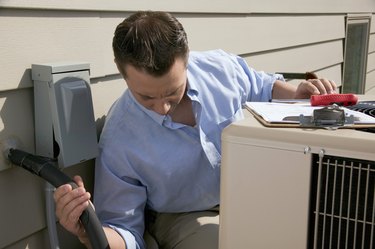
Air conditioners provide cool air to homes and add to comfort. Sometimes they allow pests easy passage into the home. When an air conditioner is installed, the installer drills a hole in the wall so that refrigerant hoses can reach the compressor. Outdoor insects and rodents crawl through the hole and into the home.
Features
Video of the Day
Inspect your home exterior for gaps or holes that let pests into the home. When air conditioner hoses run through an outside wall to the compressor, the hole is bigger than the hoses. The open space between the wall and the hose is usually caulked or filled during construction. Over time the caulking deteriorates and leaves gaps between the hose and wall. The open hole lets cold air in during winter and allows insects to crawl into the wall space. Rats, mice and other rodents use the hole for entry.
Video of the Day
Insects
Insects such as stinkbugs, ants and earwigs seek sheltered areas. Wall spaces give them protection against outside weather. Seal the wall against these pests with caulk. Acrylic caulk, easy to apply, fills small holes less than one-quarter inch. Acrylic caulk is durable but shrinks over time. This characteristic makes it unsuitable for large gaps. Other caulks, such as polyurethane, fill larger holes due to their better adhesion but are difficult to use as they do not smooth on easily. Low expanding insulation foam fills wall gaps but does not leave a smooth finish. It is messy during application and cleanup but provides a tight seal as it expands to fill wall gaps. Choose a caulk or filler based on the hole size and desired appearance.
Rodents
Rats and mice enter homes through small gaps. A mouse enters through pencil-size holes because its body stretches and elongates to squeeze past the small space. These pests chew through caulk and foam. Keep rodents out by putting a metal collar around the hole, filling the gap with steel wool, or fitting wire screen to the opening. These methods deter rodents but may not completely block cold air or insect pests. Block both insects and rodents with a combination seal. Use wire mesh or screen to fill the hole or patch over the gap, and then apply caulk over the screen to deter insects and energy loss.
Tips
Because steel wool rusts and stains walls, check your home improvement center for stainless steel or copper pads suited for sealing out rodents. These products work outside and inside the house around access holes, pipes and other pest-prone areas. While you are at the center, pick up glue traps. If you accidentally seal pests inside the house, the sticky traps catch the rodents. Unlike poison, the traps do not allow the pests to crawl away and rot inside a wall or attic.